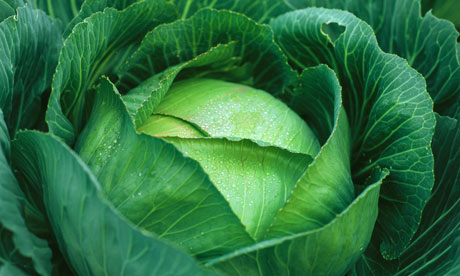How to replicate a favourite vegetarian dish, butter substitutes in baking and animal welfare in the organic dairy industry
Head start: Cabbage makes a brilliant vegetarian stew. Photograph: Getty Images/PhotoAlto
There used to be a great vegetarian restaurant in Newcastle called Supernatural, and my favourite dish there was a tomatoey cabbage stew (spring or savoy, I think)topped with potato and cheese. Any idea how I could replicate it?
I can't find a recipe, but there's a lovely Bulgarian/Serbo-Croat dish for baked white cabbage that comes pretty close. It's from the splendid The Melting Pot: Balkan Food And Cookery, by Maria Kaneva-Johnson. It doesn't use potatoes, but there's nothing to stop you adding them. You need: 1 tbsp vegetable oil; 600g white cabbage, leaves shredded and core finely chopped; salt and pepper; 135g peeled, chopped tomatoes; 1 tsp paprika; 2-3 ripe tomatoes, sliced. Heat oil in a large frying pan with a lid. Add cabbage, season with salt, cover and cook for 10 minutes, stirring occasionally, until limp. Add 2-3 tbsp water, cover, cook for 15 minutes, mix in chopped tomatoes (and potatoes); season with paprika, salt and pepper. Heat oven to 180C/350F/gas mark 4. Transfer stew to a casserole, top with sliced tomato, season and dribble oil on top. Bake for 40-45 minutes, until cabbage and tomato are charred at the edges. Slap cheese on top for last five minutes. It's as tasty cold as hot.
Several friends are going "butter-free" but I'm finding a reliable alternative hard to come by. Oil is used in carrot cakes, so can I use that?
Quite why anyone would want to live in a butter-free universe is beyond me, unless you're lactose-intolerant. In my view, none of the substitutes comes close – just eat less butter, if you're worried – but you can use margarine instead, as a look at almost any recipe from the second world war will tell you. You could use any fat, in fact: in southern Italy, pig fat is common in cakes and breads, while here beef dripping was once widely used. If you're set on using oil – olive or vegetable – there are many recipes out there. If you want to be reallyHarold McGee says, "The moistening and tenderising effects of fat – but not its aerating abilities – can be imitated by some concentrated fruit purées, notably prune, apple, apricot and pear." The result will be a moist, but heavyweight cake. health-conscious, don't use fat at all. The seer
My concern for animal welfare led me to stop eating meat, and as mainstream dairy farming involves many, to me, unacceptable practices, I think I ought to become a vegan – but don't want to. Can I be sure animals that produce organic dairy foods are not factory-farmed, and what happens to male calves?
A cow has to be pregnant to produce milk, and a good proportion of calves will be male. Female calves will go on to become the next generation of milk–producers, but the beef industry can make use of only a certain number of males for beef. It is hard to get precise figures, but somewhere between 150,000 and 250,000 male calves are shot at birth each year because we have no use for them. The organic sector is not much different from "conventional" farming in this regard, although the Soil Association is committed to ending the practice within five years. That said, welfare and husbandry standards of most agencies licensed to certify food as organic ensure that the treatment of dairy cattle is far removed from that in factory farming systems, although it's still well short of what some animal welfare organisations demand.
Got a culinary query for Matthew? Email food.for.fort@guardian.co.uk

No comments:
Post a Comment